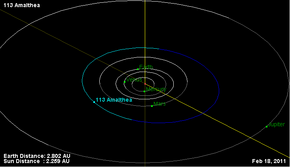 Orbital diagram | |
| Discovery | |
|---|---|
| Discovered by | R. Luther |
| Discovery site | Bilk Obs. |
| Discovery date | 12 March 1871 |
| Designations | |
| (113) Amalthea | |
| Pronunciation | /æməlˈθiːə/ |
Named after | Amalthea |
| A871 EA; 1931 TN3; 1951 CY | |
| main-belt · Flora | |
| Orbital characteristics[1] | |
| Epoch 31 July 2016 (JD 2457600.5) | |
| Uncertainty parameter 0 | |
| Observation arc | 144.90 yr (52926 d) |
| Aphelion | 2.5819 AU (386.25 Gm) |
| Perihelion | 2.17010 AU (324.642 Gm) |
| 2.37598 AU (355.442 Gm) | |
| Eccentricity | 0.086651 |
| 3.66 yr (1337.7 d) | |
| 226.48° | |
| 0° 16m 8.832s / day | |
| Inclination | 5.0422° |
| 123.486° | |
| 79.118° | |
| Physical characteristics | |
| 46.14±1.4 km | |
| 9.950 h (0.4146 d) | |
| 0.2649±0.017 | |
| S | |
| 8.74 | |
113 Amalthea (/æməlˈθiːə/) is a stony Florian asteroid from the inner regions of the asteroid belt, approximately 50 kilometers (31 miles) in diameter. It was discovered on 12 March 1871, by German astronomer Robert Luther at the Bilk Observatory in Düsseldorf, Germany. The elongated S-type asteroid has a rotation period of 9.95 hours. It was named after Amalthea from Greek mythology. A purported satellite of Amalthea was announced in July 2017, but was later found to be a software error in July 2021.[2]